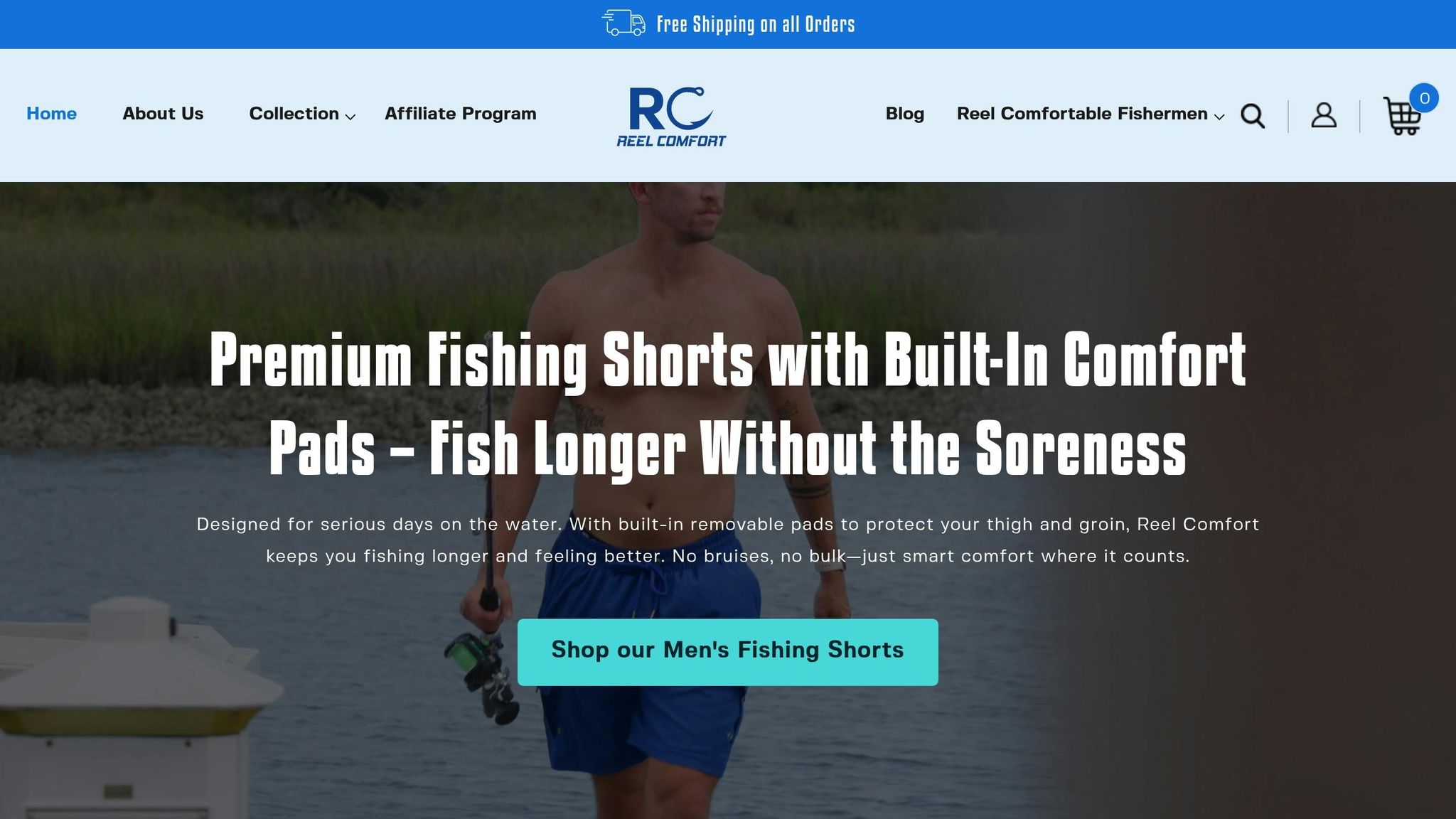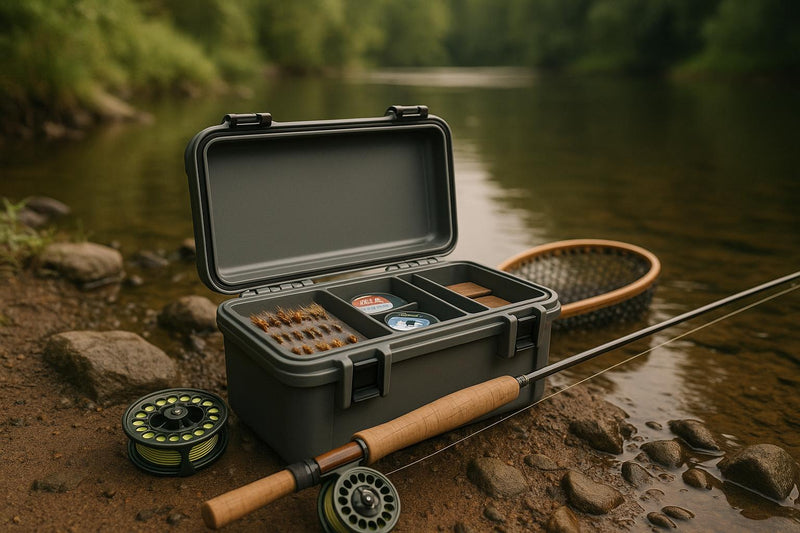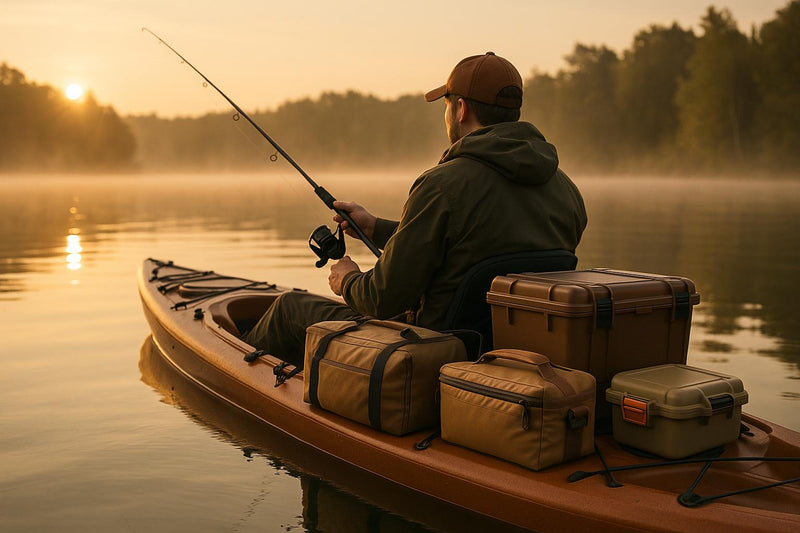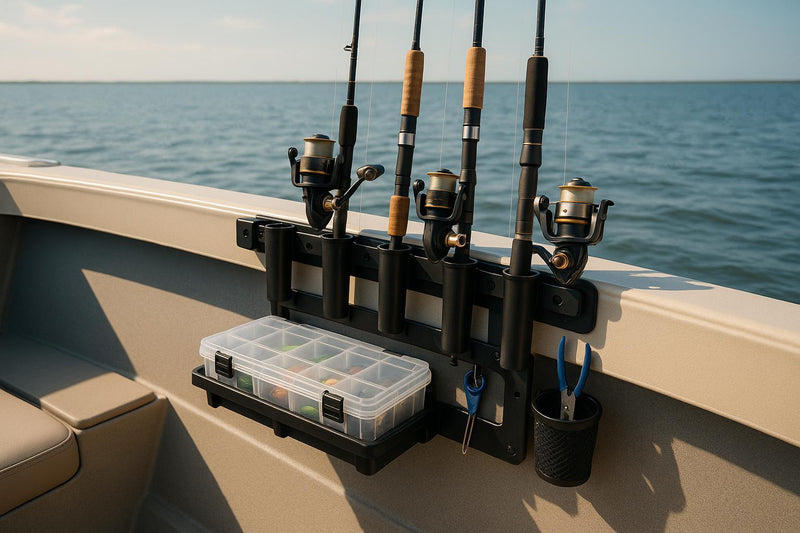When choosing fishing shorts, understanding the difference between hydrophobic and waterproof fabrics is key to staying comfortable and dry. Here's the breakdown:
- Hydrophobic fabrics repel water on the surface, making them ideal for light rain, splashes, or morning dew. They are breathable, quick-drying, and great for warm, mild conditions.
- Waterproof fabrics block water entirely, offering full protection in heavy rain or prolonged wet environments. However, they are less breathable and can feel warmer during extended use.
Quick Comparison
| Feature | Hydrophobic Fabrics | Waterproof Fabrics |
|---|---|---|
| Water Protection | Repels light rain and splashes | Blocks heavy rain and full exposure |
| Breathability | Excellent airflow | Limited airflow |
| Comfort in Heat | Cooler and more ventilated | Retains heat, less comfortable |
| Quick-Dry | Dries fast | Slower to dry |
| Durability | Coating fades over time | Long-lasting with sealed seams |
| Best Use | Mild weather, light moisture | Heavy rain, wet environments |
For most anglers, hydrophobic fabrics are the go-to for comfort and versatility in typical U.S. fishing conditions. However, waterproof fabrics are better for harsh weather or water-intensive activities. If you're looking for fishing shorts that balance water resistance with breathability, check out options like Reel Comfort's Men's Fishing Shorts, priced at $59.99.
Hydrophobic Fabric Technology in Fishing Shorts
Hydrophobic fabric technology has changed the game for anglers, making it easier to stay dry and comfortable while out on the water. These fabrics use a special coating that forms an invisible barrier, causing water to bead up and roll off instead of soaking into the material. For anglers spending long hours fishing, this technology provides a dependable way to stay protected without sacrificing comfort. Let’s dive into how these coatings work, their benefits, and some of their limitations.
How Hydrophobic Coatings Work
At the heart of hydrophobic fabrics is a treatment known as Durable Water Repellent (DWR). This coating is applied to the surface of the fabric and is often made from fluoropolymer or silicone-based compounds. These compounds create a microscopic texture on the fabric’s fibers, which prevents water from spreading out and soaking in. Instead, water forms droplets that slide right off.
DWR treatments work by lowering the surface tension of the fabric. This not only keeps moisture out but also allows the material to maintain its breathability. The open weave structure of these fabrics supports airflow, which helps them dry quickly while still offering water resistance.
Benefits of Hydrophobic Fabrics
One of the standout advantages of hydrophobic fabrics is breathability. Unlike fully waterproof materials that can trap heat and moisture, these fabrics allow air and water vapor to escape. This keeps you from feeling sweaty or overheated during long fishing trips.
These fabrics are also designed with flexibility in mind. Even when exposed to moisture, they remain soft and pliable, so you can move freely - whether you’re casting your line or maneuvering around your boat.
Hydrophobic treatments excel at repelling light rain, splashes, and other surface moisture. Whether it’s morning dew, a quick spray from the boat, or a passing drizzle, the fabric sheds water effortlessly. Plus, the quick-dry properties mean you won’t have to deal with damp clothing for long, which is a big plus during extended fishing trips.
Drawbacks of Hydrophobic Fabrics
While hydrophobic fabrics offer great water resistance, they do have their limits. Prolonged exposure to heavy rain can overwhelm the DWR coating, allowing water to seep through - especially at seams or worn areas.
The effectiveness of the treatment can also diminish over time. Repeated washing and exposure to sunlight gradually wear down the coating, meaning it may need to be reapplied to maintain performance.
It’s important to note that these fabrics are designed to repel surface moisture, not to withstand full submersion. If you’re wading in deep water, the fabric won’t keep you completely dry. Additionally, inconsistencies in fabric quality or how the treatment is applied can sometimes lead to uneven water repellency.
Reel Comfort's Hydrophobic Features

Reel Comfort has taken hydrophobic technology to the next level with its Mens Fishing Shorts. These shorts are specifically designed to handle the challenges anglers face. The fabric is treated with a premium DWR finish that holds up through repeated use, ensuring long-lasting water resistance.
The quick-dry feature works hand-in-hand with the hydrophobic coating, keeping you comfortable even when faced with morning dew or boat spray. The fabric effectively sheds moisture while maintaining excellent breathability.
For added functionality, these shorts include removable thigh pads, which provide support during intense fishing moments, such as reeling in a big catch. The pads can be easily removed for cleaning or when you need maximum range of motion.
The ergonomic design includes four-way stretch panels and anti-chafe seams, allowing the shorts to move with you, even in wet conditions. Practical storage options - like deep hand pockets and a secure zippered back pocket - are thoughtfully built to keep your essentials safe without compromising the fabric’s water-resistant capabilities.
Waterproof Fabric Technology in Fishing Shorts
Waterproof fabrics go beyond simple water repellency by creating a solid barrier that keeps water out entirely. Unlike hydrophobic treatments that only resist water on the surface, waterproof technology uses advanced multi-layer designs to ensure complete protection. For anglers braving tough weather or extended exposure to moisture, understanding these features can make all the difference in selecting the right gear.
How Waterproof Materials Work
Waterproof fabrics rely on layered construction to block water effectively. A common approach is the use of a membrane system, where a thin waterproof layer is placed between the outer shell and the inner lining. For example, GORE-TEX employs a microporous membrane that stops water droplets while still allowing sweat vapor to escape, keeping you dry inside and out.
Another method involves applying PVC coatings or polyurethane laminations directly to the interior of the fabric. This creates a continuous, non-porous layer that completely prevents water from seeping through. To reinforce these materials, manufacturers often seal needle holes with welded or taped seams, ensuring no weak points for water to penetrate.
Benefits of Waterproof Fabrics
The standout feature of waterproof fabrics is their ability to provide total water protection. These materials are built to handle heavy rain and stormy conditions, maintaining a reliable barrier against moisture. Additionally, their sealed construction ensures long-lasting durability without the need for frequent reapplications of water-repellent treatments.
Downsides of Waterproof Fabrics
While waterproof fabrics excel at keeping water out, they can sometimes compromise on breathability. The same barrier that blocks water can also limit airflow, which might cause discomfort during prolonged wear - especially in warmer weather or during high-energy fishing trips.
Waterproof Ratings Explained
Waterproof performance is measured using hydrostatic head ratings, expressed in millimeters (mm). This rating shows how much water pressure the fabric can withstand before leaking. For instance, a 5,000mm rating means the material can resist the pressure of a 5,000mm water column without letting moisture through.
Fishing shorts typically feature ratings between 5,000mm and 30,000mm. A rating in the 10,000mm to 15,000mm range strikes a good balance, offering solid water protection while still allowing for some breathability. These ratings help anglers pick fabrics that align with their specific fishing environments and needs.
While waterproof fabrics ensure excellent moisture protection, comfort is just as important. Reel Comfort's Fishing shorts combine water resistance with quick-drying features for all-day wearability. If you're after a blend of performance and comfort, check out Reel Comfort's Mens Fishing Shorts for your next fishing adventure.
Hydrophobic vs. Waterproof Fabric Comparison
When deciding between hydrophobic and waterproof fishing shorts, it's all about matching your choice to your fishing environment and personal preferences.
Key Features and Use Cases
To understand what sets these fabric technologies apart, let's break down their performance in areas that matter most to anglers:
| Feature | Hydrophobic Fabrics | Waterproof Fabrics |
|---|---|---|
| Water Protection Level | Repels light rain and splashes; water beads on the surface | Acts as a barrier against heavy rain and prolonged water exposure |
| Breathability | Allows excellent airflow due to open fabric pores | Limited airflow because of sealed barrier construction |
| Comfort in Heat | Keeps you cooler with better ventilation during hot weather | Can trap heat and moisture, especially in warm conditions |
| Quick-Dry Properties | Dries quickly thanks to water-repelling surface treatment | Slower to dry as water may collect on the surface |
| Durability | Hydrophobic finish may fade with repeated washing | Offers consistent protection with sealed seams |
| Best Fishing Conditions | Perfect for light moisture and warm, calm conditions | Best for harsh weather and extended exposure to water |
Hydrophobic fabrics are a great choice for casual fishing in mild conditions, offering excellent breathability and comfort for long, sunny days on the water. On the other hand, waterproof fabrics are your go-to for battling heavy rain or wading through wet environments, ensuring you stay dry no matter the conditions.
Reel Comfort's Mens Fishing Shorts combine the best of both worlds. These shorts feature water-resistant technology that balances effective protection with the breathability you need for all-day comfort on the water. Whether you're fishing in calm or challenging weather, these shorts have you covered.
sbb-itb-cb0a783
Which Is Better for Fishing Shorts?
Choosing the right fabric for fishing shorts depends largely on the conditions you'll face. Both hydrophobic and waterproof materials have their advantages, but knowing your typical fishing environment can help you make the best choice.
For long, sunny days spent casting from the shore or sitting on a boat in mild weather, hydrophobic fabrics are often the way to go. These materials allow your skin to breathe while offering protection from splashes and light rain. Plus, their quick-dry properties ensure you’re not stuck in damp shorts if a wave catches you off guard. On the other hand, if you're wading through streams, fishing in heavy rain, or dealing with consistently wet conditions, waterproof fabrics provide better protection. However, they can feel warmer and less breathable during extended use.
For most recreational anglers, the breathability and quick-dry features of hydrophobic fabrics often outweigh the need for full waterproofing. Let’s dive into how these fabrics align with typical fishing conditions in the U.S.
Best Choice for US Fishing Conditions
Across the diverse fishing landscapes of the U.S. - from northern lakes to southern coasts - breathability is key. During hot summer days, when temperatures soar past 80°F, staying cool and comfortable is essential. Whether you’re bass fishing in the Texas heat or trolling for salmon in the Pacific Northwest, you’ll want shorts that keep you dry without trapping heat and moisture.
Hydrophobic fabrics excel in managing the unpredictable weather patterns common to many American fishing spots. From sudden Florida thunderstorms to morning dew on Midwest lakes or splashes from passing boats, these fabrics repel water efficiently while keeping you comfortable.
Reel Comfort’s Fishing shorts strike the perfect balance between water resistance and breathability, making them ideal for dynamic fishing conditions. Their water-resistant fabric technology guards against splashes and light rain, while quick-dry properties ensure you won’t be stuck in wet shorts when conditions shift. Plus, the four-way stretch panels provide full mobility, whether you’re casting, reeling, or moving around your boat.
For most U.S. anglers - from casual weekend fishers to serious tournament competitors - shorts that combine comfort, breathability, and water protection offer a superior experience. At $59.99, these Mens Fishing Shorts deliver professional-grade performance without the discomfort often associated with fully waterproof gear.
Unless you’re fishing in heavy, prolonged wet conditions, hydrophobic fabrics provide the ideal balance of comfort and protection for the way most Americans fish. Check out Reel Comfort’s premium Fishing shorts to elevate your next fishing trip.
Conclusion
Knowing the difference between hydrophobic and waterproof fabrics can make a big difference in your fishing experience. Hydrophobic fabrics are designed to repel water while staying breathable, making them a great choice for most fishing situations where comfort and quick-drying features are key. On the other hand, waterproof fabrics provide full water protection but often come at the expense of breathability and long-term comfort.
The right choice depends on your fishing style and the conditions you face. For most American anglers - whether you're casting lines in an Alabama bass boat or surf fishing along California's coastline - hydrophobic fabrics strike the perfect balance between protection and comfort.
Final Thoughts on Hydrophobic vs. Waterproof
If you don’t need full waterproofing, hydrophobic fabrics offer versatile performance that adjusts to changing conditions throughout the day. They provide reliable water resistance while keeping you comfortable during long hours on the water.
This balance of functionality and comfort is exactly what makes Reel Comfort's Fishing shorts a standout choice for the diverse fishing conditions found across the U.S. These shorts are designed with water-repelling technology and excellent breathability, ensuring they perform as well as they feel. With features like removable thigh pads, ergonomic design, reinforced stitching, and anti-chafe seams, these shorts are built for serious anglers who value both comfort and durability.
At $59.99, these Mens Fishing Shorts deliver professional-level comfort, support, and long-lasting quality for any fishing environment. Available in classic black, versatile gray, and bold blue, they combine practicality with style.
Reel Comfort's Fishing shorts represent the next step in fishing apparel - where advanced fabric technology meets smart design to meet the needs of today’s anglers. Choose the fabric that suits your fishing environment and enjoy a comfortable, high-performance experience out on the water.
FAQs
How do you care for and maintain hydrophobic vs. waterproof fishing shorts?
Caring for hydrophobic and waterproof fishing shorts requires a slightly different approach to keep them performing well and lasting longer.
Hydrophobic fabrics are designed to repel water on contact, so they’re relatively low-maintenance. A gentle wash with mild detergent is usually all they need. However, to maintain their water-repelling properties, you might occasionally need to reapply a water-repellent spray.
Waterproof shorts, on the other hand, are built to block water even under pressure, which means they need a bit more attention. Avoid using harsh detergents or exposing them to high heat, as these can harm the waterproof membranes. Over time, you may need to re-coat or re-seal them to restore their full protective capabilities. Always stick to the manufacturer’s care guidelines to ensure your fishing shorts are ready for your next adventure.
What’s the difference between hydrophobic and waterproof fabrics, and which is better for fishing shorts?
Hydrophobic fabrics are specially treated to make water bead up and roll off their surface. While this feature is handy, the coating can wear down over time due to things like UV exposure, frequent washing, or abrasion. As a result, the water-repelling ability may fade with extended use.
On the other hand, waterproof fabrics are built differently. They use more durable treatments or membranes that form a stronger barrier against water. This makes them a more reliable option for activities like fishing, where staying dry isn't just a comfort - it's a necessity.
For fishing shorts that balance water resistance, comfort, and durability, take a look at the collection available at Reel Comfort.
When should you choose waterproof fishing shorts instead of hydrophobic ones?
When you're out fishing and expecting heavy rain, splashing waves, or extended time in wet conditions, waterproof fishing shorts are a game-changer. Unlike hydrophobic fabrics that repel water but can let moisture seep through under intense exposure, waterproof materials are designed to keep you completely dry.
These shorts are especially handy for activities like boat fishing in choppy waters, fishing during stormy weather, or wading through areas where you're constantly getting splashed. Staying dry isn't just about comfort - it's also about staying focused and safe while you enjoy your time on the water.




